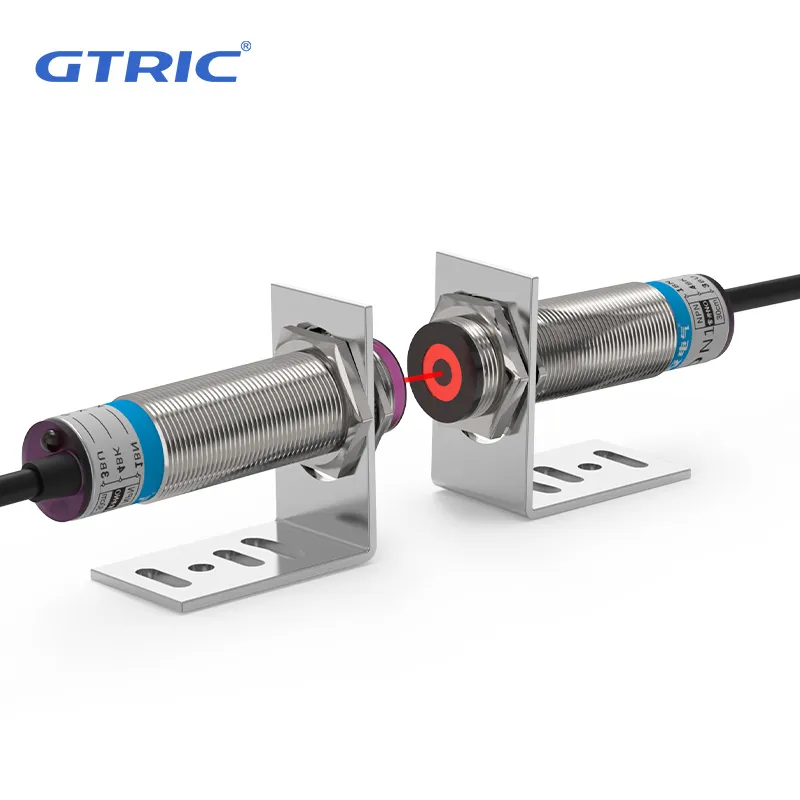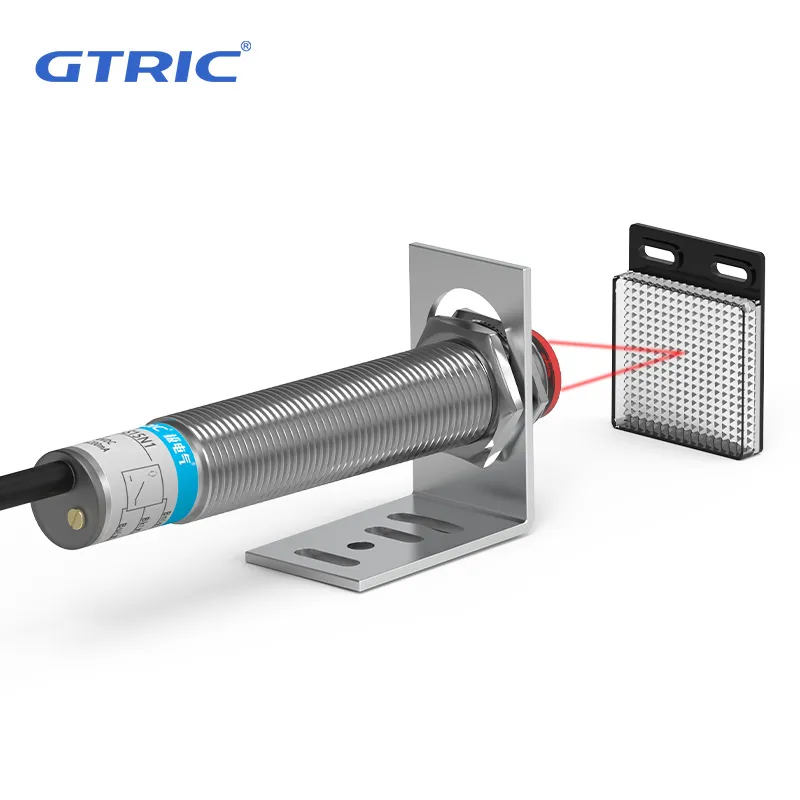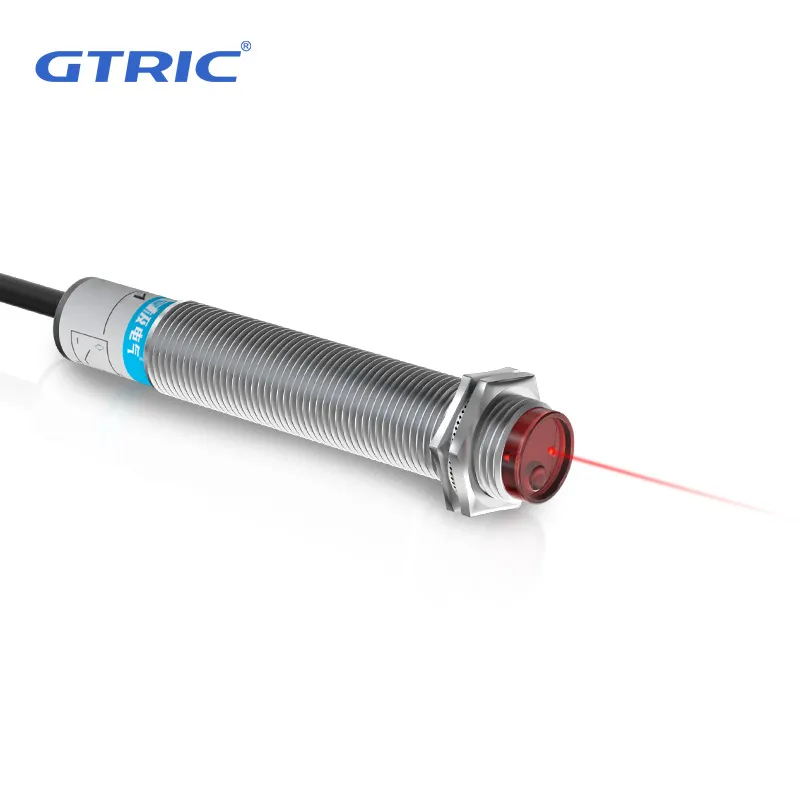Photoelectric sensors reliably form the backbone of industrial automation, often going unnoticed. They detect objects, count products, and keep machines safe — all without ever making contact. In manufacturing plants, warehouses, and even everyday equipment like automatic doors, these small devices often decide whether a process runs smoothly or grinds to a halt.
In this guide, we’ll explore how they work, what’s inside, where they shine, where they fall short, and how to wire them for reliable performance.
How Do Photoelectric Sensors Operate?
At their core, photoelectric sensors use light-based detection to sense the presence, absence, or distance of an object. The process follows a straightforward sequence:
- Light Emission – A light source, typically an LED, sends out a focused beam, either visible or infrared.
- Detection – A receiver monitors this beam for interruptions or reflections caused by an object.
- Signal Output – When a change is detected, the sensor sends an electrical signal to a machine controller or other device.
In a packaging line, the sensor’s beam is aimed across the conveyor. As each carton passes, it blocks the light, triggering the counter. A gap in cartons allows the beam to pass uninterrupted, telling the conveyor control system to stop feeding new boxes.
Quick Demo Tip:
Test sensor alignment calibration by introducing a target into its sensing field. The sensor should react instantly. If the reaction is delayed or inconsistent, the emitter and receiver may need repositioning.
Photoelectric Sensors – Structure, Principle, and Function
A typical sensor is more than just a light and a switch. It includes:
- Emitter – Produces the light beam.
- Receiver – Detects the beam and interprets changes.
- Housing – Protects components; industrial models often meet IP65–IP69K for dust and water resistance.
- Signal Processing Circuit – Translates optical changes into electrical outputs.
Three Core Detection Principles:
| Type | How It Works | Common Use Case |
| Through-Beam | Interruption detection with aligned emitter-receiver pair. | Detecting pallets on long conveyors |
| Retro-Reflective | Integrated into a single unit, the emitter-receiver pair utilizes a reflective target for beam return. | Detecting large boxes in a warehouse |
| Diffuse-Reflective | Reflective sensing method using a unified emitter-receiver assembly. | Detecting bottles, labels, or small parts |



Knowing the detection principle helps engineers match the sensor type to the job. For example, a diffuse-reflective sensor is quick to install but won’t detect over long distances. In contrast, a through-beam sensor offers long-range accuracy but demands precise alignment.
Limitations of Photoelectric Sensors
Despite their versatility, photoelectric sensors have limits that engineers must work around:
- Dust and Dirt Sensitivity – Lens contamination can block or scatter the beam.
- Material Reflectivity Issues – Transparent glass, shiny metal, or matte black surfaces can challenge detection.
- Ambient Light Interference – Sunlight or strong artificial light may cause false triggers.
- Alignment Requirements – Through-beam systems require careful installation to ensure consistent detection.
A beverage plant struggled to detect clear PET bottles. The standard sensors worked fine for colored bottles but failed with transparent ones.
Classification of Photoelectric Sensors
By Detection Method:
- Through-Beam – Longest range, highest reliability, requires two units.
- Retro-Reflective – Single housing plus a reflector; easier to install.
- Diffuse-Reflective – Most compact and cost-effective for short ranges.
By Structure:
- Unibody construction containing optical components and electronics.
- Remote – Optical components in the field, electronics in a separate control box.
- Fiber Optic – Light transmitted via flexible fibers for high-heat, corrosive, or tight-space installations.
Photoelectric Sensors for Applications
These units serve critical functions in multiple, often unforeseen, industrial settings:
- Manufacturing – Detecting missing bolts in automotive assembly.
- Logistics – Counting packages at high speed before sorting.
- Food & Beverage – Ensuring bottles are correctly positioned before filling.
- Public Safety – Preventing automatic doors from closing on pedestrians.
Specialized Application Areas
- Harsh Environments – IP69K-rated models withstand high-pressure cleaning in food plants.
- Micro-sized sensors ensure detection of sub-millimeter components in PCB manufacturing.
- Transparent Objects – Specialized optics detect glass panes or clear plastic sheets.
Long-Distance Detection – Through-beam sensors monitor security gates up to 50 meters away. - Label Detection – It excels in identifying fast-moving materials such as labels, films, and paper.
Wiring Configurations for Photoelectric Sensors
Correct wiring is essential for safe and reliable performance.
Common Configurations:
- 2-Wire DC – Combines power supply and signal transmission over two conductors.o wires.
- 3-Wire DC (NPN/PNP) – Industry standard; separates signal from power for better control integration.
- 4-Wire DC – Offers both normally open (NO) and normally closed (NC) outputs.
Before installation, verify whether your PLC or controller expects an NPN (sinking) or PNP (sourcing) output. A mismatch can result in false readings or no output.
Frequently Asked Questions (FAQs)
Q: Can photoelectric sensors detect transparent objects?
A: Yes — with the right model. Polarized retro-reflective types or sensors with specialized transparent object detection modes work best.
Q: How far can they detect?
A: Through-beam models can detect up to 50 m. Diffuse-reflective types are typically under 2 m.
Q: Are they affected by temperature?
A: Extreme heat or cold can shift detection accuracy. Always check the manufacturer’s temperature range specifications.
Q: How often should they be cleaned?
A: In dusty or oily environments, inspect weekly. Cleaner conditions allow performance stability to be maintained with monthly checks.
